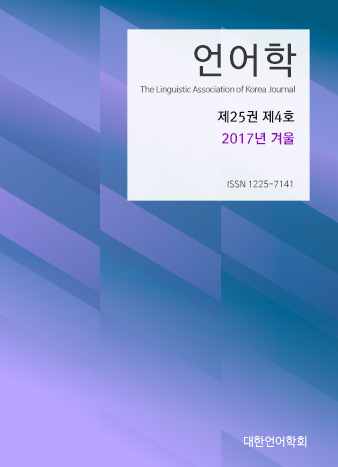대한언어학회 전자저널

25권 4호 (2017년 12월)
- A Study on Resyllabification and Palatalization in Korean
-
Kyung Ae Choi & Dae Hwan Joo
Pages : 23-40
Abstract
Choi, Kyung Ae & Joo, Dae Hwan. (2017). A study on resyllabification and palatalization in Korean. The Linguistic Association of Korea Journal, 25(4). 23-40. The purpose of this paper is to examine the phonological unit associated with phonological phenomena, emphasizing the vital role of resyllabification and ambisyllabicity in the word formation process to study palatalization in Korean in the framework of lexical phonology. By studying examples and counterexamples in similar phonological environments, we discover that the phonological word (Pw) is the unit in which resyllabification occurs in Korean. Another suggestion is that all words or phrases automatically go through a syllabification device (SD) whenever new word formation occurs in phonology in order for resyllabification to take place. To conclude, palatalization in Korean is a phonological phenomenon taking place in derived environment when the preceding coronal consonants share the feature of [+high] with the following sound by becoming an ambisyllabic element as a consequence of the resyllabification achieved by passing through the SD within the domain of the phonological word.
Keywords
# palatalization # resyllabification # ambisyllabicity # phonological word # syllabification device
References
- Ahn, S.-C. (1985). The interplay of phonology and morphology in Korean. Unpublished doctoral dissertation, University of Illinois at Urbaba-Champaign.
- Ahn, S.-C. (1988). Eohwi eumunlon seoseol (‘Explanation of lexical phonology’). Linguistic Research, 8, 1-24.
- Borowsky, T. (1984). On resyllabification in English. Unpublished manuscript. University of Massachusetts, Amherst.
- Chomsky, N., & Halle, M. (1968). The sound pattern of English. New York: Harper and Row.
- Choi, K.-A. (1988). The syllable in English phonology: A lexical approach. Unpublished doctoral dissertation, Ewha Womans University, Seoul, Korea.
- Choi, K.-A. (1991). Kugaeeumhwa-e daehan eumjeoleumunlonjeok yeongu (‘Palatalization in syllabic phonology’). Language and Literature Studies, 1, 73-83.
- Choi, K.-A., & Lee, K.-E. (2000). Choejeokilon-e euihan kugaeeumhwa jaebunseok (‘Ambisyllabicity and palatalization of English in the optimality theory’). Language and Literature Studies, 9, 127-150.
- Halle, M., & Mohanan, K. (1985). Segmental phonology of modern English. Linguistic Inquiry, 16(1), 57-116.
- Kim, M.-R., & Kim, O.-Y. (2009). Korean phonology. Seoul, Korea: Semunsa.
- Kiparsky, P. (1982a). From cyclic phonology to lexical phonology. In H. van der Hulst & N. Smith (Eds.), The structure of phonological representations, Part 1 (pp. 131-76). Dordrecht: Foris.
- Kiparsky, P. (1982b). Lexical phonology and phonology. In I.-S. Yang (Ed.) Linguistics in the morning calm (pp. 3-91). Seoul: Hanshin.
- Kiparsky, P. (1983). Word formation and the lexicon. In F. Ingemann (Ed.), Proceedings of the 1982 Mid-America Linguistics Conference, (pp. 3-29). Lawrence, KS: Univ. of Kansas.
- Kiparsky, P. (1985). Some consequences of lexical phonology. Phonology Yearbook 2, 85-138.
- Levin, J. (1983). Reduplication and prosodic structure. Unpublished manuscript, MIT.
- Mohanan, K. P. (1982). The theory of lexical phonology. Doctoral dissertation, MIT. Published in 1986. Dordrecht: Reidel.
- Nespor, M., & Vogel, I. (1986). Prosodic phonology. Dordrecht: Foris
- Shin, S.-Y. (2013). Korean phonology. Seoul, Korea: Yeonlak.